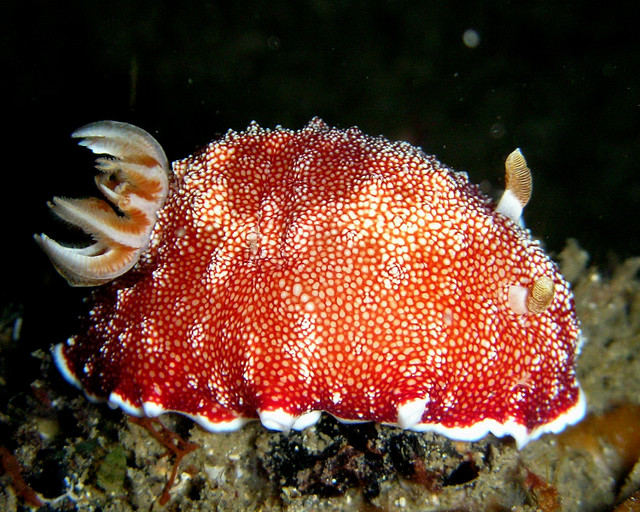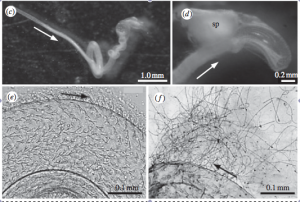Sea slug disposes penis, regrows within 24 hours

“Chromodoris reticulata” by Stephen Childs. Flickr, 19 Apr 2010.
URL:http://www.flickr.com/photos/steve_childs/4556634437/sizes/z/in/photostream/ (Accessed on 1 Apr 2013)
Today, we can pretty much find many of the things we use in disposable forms; disposable napkins, disposable cameras, disposable utensils are just the norm, but what about disposable penis? The red and white spotted hermaphrodite sea slug, Chromodoris reticulata might not look appealing to most but this small sea creature has the unique and unusual ability to remove its penis after copulation.
Most slugs are hermaphrodite meaning that they have the male and female reproductive organs. The Chromodoris reticulata is a simultaneous hermaphrodite which has both the female and male reproductive organ at the same time and in the particular case of reciprocal copulation, both partners provide sperm.
What stands out in the mating behavior of the Chromodoris reticulata is the observation that this particular sea slug species actually autotomize (spontaneous casting off of a limb or other body part) its penis after each copulation but yet are able to ‘regrow’ its penis to copulate again within 24 hours.
In the research article “Disposable penis and its replenishment in a simultaneous Hermaphrodite” researchers have identified a spiral structure within the slug that is suggested to be crucial in the autotomy and replacement of the penis. It is proposed by the researchers that the “tissue at the spiral part of the penis is compressed and undifferentiated, gradually differentiating into the ‘next penis’”. This also suggests why there is usually a long time interval between copulations as the research shows that individuals who have engaged in reciprocal copulation prior are less inclined to engage in copulation again even if it was copulation solely in the female role.
Examination of the anatomy of the autotomized penis showed that the surface is equipped with backward pointed spines, sperms entangled in the spine and a somewhat swollen tip. Researchers have suggested that these structures may serve to remove foreign sperm in the mating partners to increase the chances of fertilization by the particular slug due to competition.

Figure 1: (c,d) Auto- tomized penes after copulation; the tip of the penis is swollen. A mass of sperm (sp) is attached to the thorny penis in (d ). (e) Surface of the penis is equipped with innumerable backward-pointed spines. (f) Sperm are entangled in the spines. Autotomized penis stained with haematoxylin after being air-dried on a glass slide. Arrows show the direction of penis insertion.
“Figure 1” Sekizawa A, Seki S, Tokuzato M, Shiga S, Nakashima Y. Disposable penis and its replenishment in a simultaneous hermaphrodite. 2013 Biol Lett 9: 20121150. http://dx.doi.org/10.1098/rsbl.2012.1150
It is believed that the transformation and extension of the penis during copulation and the existence of backward pointed spines on the surface of the penis makes it difficult for the penis to be withdrawn after copulation, thus making up the main reason for the Chromodoris reticulata to autotomize their penis.
However, it does not seem that process of removing and replacing of penis in the Chromodoris reticulata can be repeated for an infinite number of times. Based on the average length of the internal penis including the spiral structure, it is estimated that penes were sufficiently long for three copulations, but it has not been suggested that these structures are able to regrow for further copulation.
Such bizarre behavior of removing its penis has not been observed in other species of sea slugs and many questions are still unanswered in the study of this amazing species. Well it certainly seems conveneint for the sea slug to have a disposible penis, but with only three chances, I am sure the guys around will not approve of it.
References:
1. Sekizawa A, Seki S, Tokuzato M, Shiga S, Nakashima Y., 2013. Disposable penis and its replenishment in a simultaneous hermaphrodite. Biol Lett 9: 20121150. http://dx.doi.org/10.1098/rsbl.2012.1150
2. Michiels NK., 1998. Mating conflicts and sperm competition in simultaneous hermaphrodites. Birkhead TR, Møller AP (eds), Sperm Competition and Sexual Selection, pp. 219 – 254. London, UK: Academic Press.